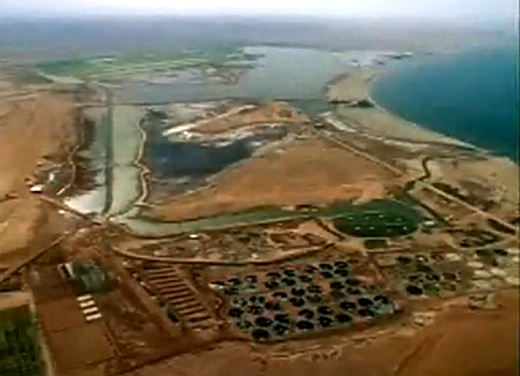SUBHEAD: Stark contrast to industrial aquaculture, where they throw cheap energy on unsustainable systems to maximize profit.
By Oyvind Holmstad on 30 March 2011 in Permaculture RI -
(http://permaculture.org.au/2011/03/30/sea-water-farming/#more-5369)

Image above: Closed loop shrimp farm where effluent goes to farmland. Still frame from "Eritria - Part 1" vedio below.
The two videos below are much about scaling up mangrove systems for sustainable sea water farming, done in a true permaculture spirit from which both people and nature benefit. Sadly this is in stark contrast to industrial aquaculture, where they throw cheap energy on unsustainable systems to maximize profit.
Today mangroves are disappearing fast. Thirty-five percent of mangrove ecosystems disappeared between 1980 and 2000, according to the Millennium Ecosystem Assessment. Shrimp farms have been a primary cause of mangrove loss, as well as urbanization and agriculture. This is why the message from The Seawater Foundation is of such an importance, as they show how to change and provide hope for the future.
Video above: "Greating Eritria" Part 1. From (http://www.youtube.com/watch?v=_P1rPnVUME4).
Video above: "Greating Eritria" Part 2. From (http://www.youtube.com/watch?v=NnzIg3XdcjY).
A similar form of sustainable shrimp farming is the Chinese Gei Wai, a shallow fish pond surrounded by bunds. Make sure you get real mangrove prawns on your pizza next time you order a sea food topping!
Mangroves and other coastal ecosystems provide a lot services for humanity, among them is their capacity to capture and store CO2. Carbon sinks along the world’s coast lines, including mangroves, sea grasses, and tidal salt marshes, store massive quantities of carbon for centuries at a time, and could provide an immediate and cost-effective tool to counter the impacts of climate change.
Video above: "WWF Living Planet Report 2010 - Mangroven". From (http://www.youtube.com/watch?v=L7Pw7TGQRMU)
.
By Oyvind Holmstad on 30 March 2011 in Permaculture RI -
(http://permaculture.org.au/2011/03/30/sea-water-farming/#more-5369)

Image above: Closed loop shrimp farm where effluent goes to farmland. Still frame from "Eritria - Part 1" vedio below.
The two videos below are much about scaling up mangrove systems for sustainable sea water farming, done in a true permaculture spirit from which both people and nature benefit. Sadly this is in stark contrast to industrial aquaculture, where they throw cheap energy on unsustainable systems to maximize profit.
Today mangroves are disappearing fast. Thirty-five percent of mangrove ecosystems disappeared between 1980 and 2000, according to the Millennium Ecosystem Assessment. Shrimp farms have been a primary cause of mangrove loss, as well as urbanization and agriculture. This is why the message from The Seawater Foundation is of such an importance, as they show how to change and provide hope for the future.
Video above: "Greating Eritria" Part 1. From (http://www.youtube.com/watch?v=_P1rPnVUME4).
Video above: "Greating Eritria" Part 2. From (http://www.youtube.com/watch?v=NnzIg3XdcjY).
A similar form of sustainable shrimp farming is the Chinese Gei Wai, a shallow fish pond surrounded by bunds. Make sure you get real mangrove prawns on your pizza next time you order a sea food topping!
Mangroves and other coastal ecosystems provide a lot services for humanity, among them is their capacity to capture and store CO2. Carbon sinks along the world’s coast lines, including mangroves, sea grasses, and tidal salt marshes, store massive quantities of carbon for centuries at a time, and could provide an immediate and cost-effective tool to counter the impacts of climate change.
Video above: "WWF Living Planet Report 2010 - Mangroven". From (http://www.youtube.com/watch?v=L7Pw7TGQRMU)
.
No comments :
Post a Comment